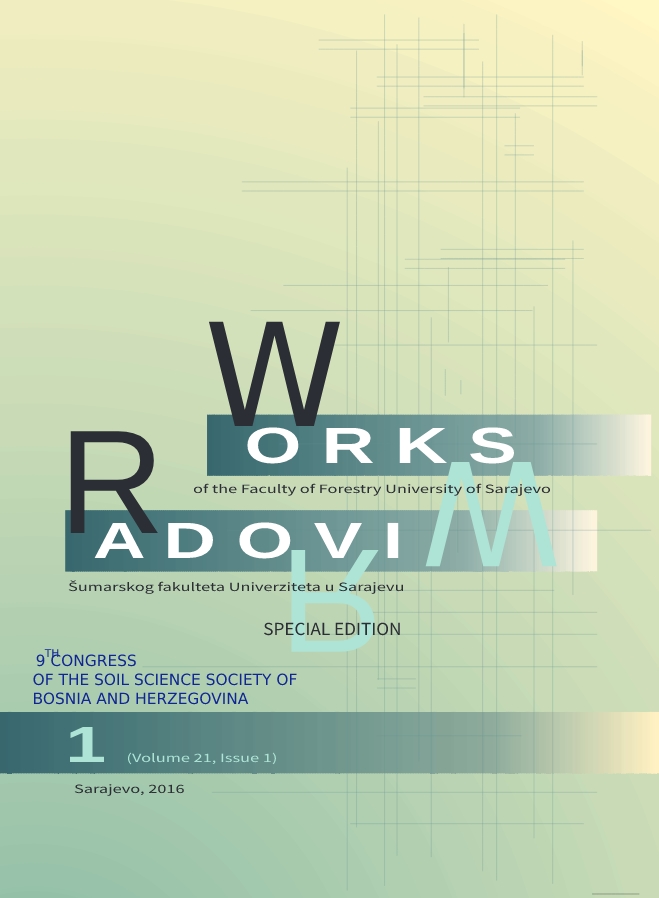THE STATE OF SOIL ORGANIC MATTER IN DIFFERENT PHYSICAL FRACTIONS DEPEND ON LAND USE TYPE
DOI:
https://doi.org/10.54652/rsf.2016.v1.i1.290Ključne riječi:
soil organic matter, physical fractions, type of land useSažetak
UDK 631.417(497.6)
Known fact is that arable soils compared with correspondent native soils differ in the state of soil organic matter (SOM) and that agricultural practices halved content of soil organic carbon in last decades. Further, soil structure or aggregation mediates many biological and chemical processes in soil and influence on protecting of SOM. The objectives of this paper is to analyze how the different land use (forest, grassland and arable soil) effects on quality and quantity of SOM in different physical fraction. In particular, it is important to determine what pool (physically separated fraction) of SOM is most sensitive on cultivation and what pool is more resistant to mineralization.
The research is carried out on two soil type with different texture, Pseudogley and Terra rossa, in condition of different climate and soil management. Two groups of SOM analysis are singled out: 1) quantify SOC and N storage, and δ13C by horizons; and 2) quantify the SOC and N in the following physically separated fractions of SOM: a) coarse and fine particulated organic matter (POM) density <1.8 gcm-3; b) occluded POM in stable microaggregates 53-250 µm; and c) SOM in small microaggregates <53 µm.
Downloads
References
Bruce J. P., Frome M., Haıtes E., Janzen H., Lal R., Paustıan K., 1998, Carbon Sequestration in Soils - Workshop, Soil and Water Conservation Society, Calgary- Alberta,1988, 6-7.
Curtin D., Selles F., Wang H., Campbell C. A., I Biederbeck V. O., 1998, CO2 Emissions and Transformations of Soil Carbon and Nitrogen during Wheat Straw Decomposition, Soil.Sci.Am.J. 62:1035-1041 (1998).
Golchin A., J. A. Baldock, P. Clarke, T. Higashi and J. M. Oades, 1997, The effects of vegetation and burning on the chemical composition of soil organic matter of a volcanic ash soil as shown by 13C NMR spectroscopy. II. Density fractions, Received 2 July 1996; accepted 28 November 1996.; Available online 5 June1998, science@direct.
John B. M., 2003. Carbon turnover in aggregated soils determined by natural 13C abundance, doktorska disertacija na Georg-August-Univerzitetu u Goettingenu, 4-18.
John B., Yamoshıta T., Ludwıg B., Flessa H., Storage of organic carbon in aggregate und density fractions of silty soils under different types and land use, available online at "http://www.sciencedirect.com" 2004, 1-2, 4.
Lal R., Grıffın M., Apt J., Lave L., Morgan M.G., 2004, Managing Soil Carbon, VOL 304, SCIENCE, www.sciencemag.org
Scheffer, F., Schachtschabel, P., 2002. Lehrbuch der Bodenkunde. 15st edition. Spektrum Akademischer Verlag, Heidelberg. 593 pp.
Six J., Callewaert P., Lenders S., De Gryze S., Morris S.J., Gregorich E. G.,.Paul E.A, I Paustian K., 2002a. Division S-7 – Forest and range soils; Measuring and Understanding Carbon Storage in Afforested Soils by physical Fractionation, Published in Soil Sci. Soc. Am J. 66:1981-1987 (2002a).
Sıx J., Conant R. T., Paul E. A. I Paustıan K., 2002b, Stabilization mechanisms of soil organic matter: Implications for C-saturation of soils, Kluwer Academic Publishers, Plant and Soil 241: 155-176.























